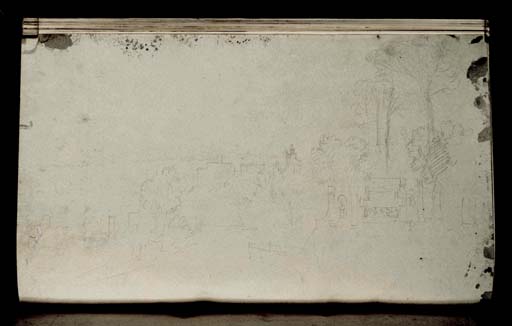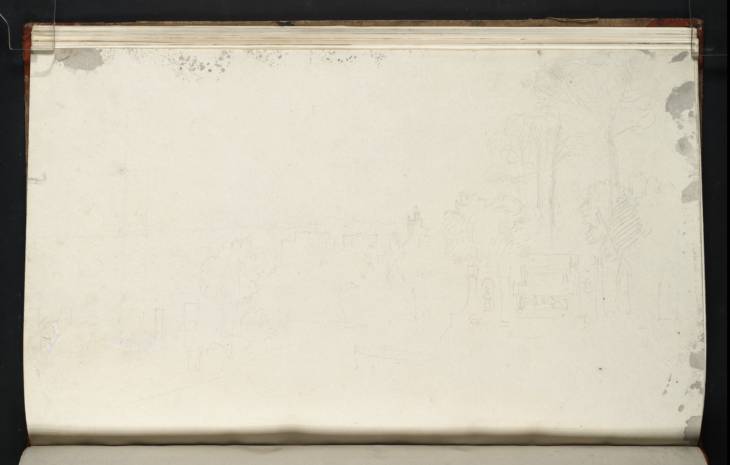Joseph Mallord William Turner View of the Janiculum Hill, Rome, from the Gardens of the Villa Lante, with San Pietro in Montorio and the Fontana dell'Acqua Paola 1819
Image 1 of 2
-
 Joseph Mallord William Turner, View of the Janiculum Hill, Rome, from the Gardens of the Villa Lante, with San Pietro in Montorio and the Fontana dell'Acqua Paola 1819
Joseph Mallord William Turner, View of the Janiculum Hill, Rome, from the Gardens of the Villa Lante, with San Pietro in Montorio and the Fontana dell'Acqua Paola 1819 -
 Joseph Mallord William Turner, View of the Janiculum Hill, Rome, from the Gardens of the Villa Lante, with San Pietro in Montorio and the Fontana dell'Acqua Paola 1819 (Enhanced image)Enhanced image
Joseph Mallord William Turner, View of the Janiculum Hill, Rome, from the Gardens of the Villa Lante, with San Pietro in Montorio and the Fontana dell'Acqua Paola 1819 (Enhanced image)Enhanced image
Joseph Mallord William Turner,
View of the Janiculum Hill, Rome, from the Gardens of the Villa Lante, with San Pietro in Montorio and the Fontana dell'Acqua Paola
1819
Joseph Mallord William Turner 1775–1851
Folio 49 Verso:
View of the Janiculum Hill, Rome, from the Gardens of the Villa Lante, with San Pietro in Montorio and the Fontana dell’Acqua Paola 1819
D40856
Pencil and traces of grey watercolour wash on white wove ‘Valleyfield’ paper, 229 x 368 mm
Accepted by the nation as part of the Turner Bequest 1856
The subject of this sketch is a view of the Janiculum Hill from the gardens of the Villa Lante, a sixteenth-century summer-house designed by Giulio Romano (circa 1499–1546). The villa was famed for its view from the loggia, and an epigram by the ancient poet, Valerius Martial, carved above a doorway in the loggia testifies to the fame of the prospect: ‘HINC TOTAM LICET AESTIMARE ROMAM’ [Here one can take the measure of all Rome].1 Turner appears to have been standing in the terraced gardens beneath the Villa looking towards the southern tip of the hill with the Church of San Pietro in Montorio on the left, and the Fontana dell’Acqua Paola (Fountain of the Pauline Aqueduct) on the right. The same decorative wall with sculptures in niches in the bottom right-hand corner can be seen in another page from this sketchbook (see D16338; Turner Bequest CLXXXIX 12) and a similar vista appears in the Small Roman C. Studies sketchbook (Tate D16449; Turner Bequest CXC 36).
In addition to the Villa Lante, Turner made a thorough exploration of various other locations on the Janiculum using several sketchbooks. He made a large number of drawings from the oak of Torquato Tasso at the northern end of the hill in the Rome C. Studies sketchbook (Tate D16378; Turner Bequest CLXXXIX 49), the St Peter’s sketchbook (Tate D16158–D16165; Turner Bequest CLXXXVIII 2–5), and the Small Roman C. Studies sketchbook (Tate D16446–D16447; Turner Bequest CXC 34a–35). Finally he explored the views from the southern tip of the hill, from San Pietro in Montorio (Tate D16328; CLXXXIX 2 and Tate D15447–D15449; Turner Bequest CLXXXII 78a–79a), the Fontana dell’Acqua Paola (Tate D15450; Turner Bequest CLXXXII 80) and from the Villa Amelia (Tate D16353; Turner Bequest CLXXXIX 27 and D40049). The extended series of sketches suggests that he was seriously exploring the subject as a potential picture in oil or watercolour. His interest ultimately led to a finished watercolour, Rome, San Pietro in Montorio circa 1820–1 (Courtauld Institute of Art, London) which he produced following the 1819 tour for his great friend and patron, Walter Fawkes.2
Nicola Moorby
July 2009
Quoted in James F. O’Gorman, ‘The Villa Lante in Rome; Some Drawings and Some Observations’, Burlington Magazine, vol.113, no.816, March 1971, p.133.
Andrew Wilton, The Life and Work of J.M.W. Turner, Fribourg 1979, no.720, as ‘Rome, from the Pincian Hill’. First identified with correct title by David Hill in Turner in Yorkshire, exhibition catalogue, York City Art Gallery, York 1980, no.97, p.64. Reproduced in colour in The Courtauld Collection, exhibition catalogue, Wordsworth Trust, Grasmere 2008, no.16.
How to cite
Nicola Moorby, ‘View of the Janiculum Hill, Rome, from the Gardens of the Villa Lante, with San Pietro in Montorio and the Fontana dell’Acqua Paola 1819 by Joseph Mallord William Turner’, catalogue entry, July 2009, in David Blayney Brown (ed.), J.M.W. Turner: Sketchbooks, Drawings and Watercolours, Tate Research Publication, December 2012, https://www

